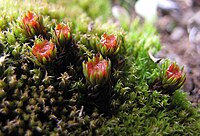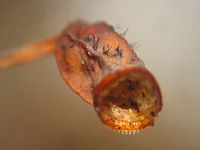Polytrichum piliferum
| Polytrichum piliferum | ||||||||||||
|---|---|---|---|---|---|---|---|---|---|---|---|---|

Polytrichum piliferum |
||||||||||||
| Systematics | ||||||||||||
|
||||||||||||
| Scientific name | ||||||||||||
| Polytrichum piliferum | ||||||||||||
| Schreb. ex. Hedw. |
Polytrichum piliferum is a moss that is found in Central Europe quite often in sandy or rocky, nutrient-poor locations. In German, the moss as is glass hair hair cap moss , Glass fiber Widertonmoos or hair wearing women's hair moss called.
The moss has a special adaptation to warm and dry locations. The middle upper side of the leaflets is translucent. It is said to help prolong photosynthesis and hinder evaporation. The coarse-walled underside of the leaflet should reflect heat rays and thus counteract any heating. The hair should be conducive to the rapid, additional absorption of water. The leaves, which turn upwards towards the inside when water is lost, reduce the irradiation area. The plants should be able to withstand temperatures of up to 70 ° C.

description
The moss forms loose cushions. In unfavorable locations, the individual plants are also at some distance from one another. They usually reach heights of well below 3 cm. They only get larger in exceptional cases. The cushions are often noticeably blue-green, but there are also pure green or brown-green plants.
The species is not rhizoid-tomentose, but the rhizoids in the soil are well developed and can form new shoots over a long period of time. This is an adaptation especially to sandy locations.
Like all species of the genus, the leaves have a sheath part that is water-white except for the midrib and a lanceolate, coarse tip. The tip ends here in a glass hair, the length of which can be very different, but which is almost always visible to the naked eye. With this one can easily distinguish the species from the other species of the genus with the naked eye. The tip of the leaf is entire, and its edges are folded in.
The perichaetium , the so-called moss blossom, is noticeably dark red in this species. The capsules stand on a seta up to 3 cm long . They are square and have an offset capsule neck.
Distribution and location requirements
Polytrichum piliferum is cosmopolitan (all continents including Antarctica ). In Central Europe it is common and widespread everywhere from the lowlands to the high mountains.
It grows above all in unrivaled, often extremely nutrient-poor locations, such as on sand or slightly over-earthed rocks, also on acidic soils. It tolerates strong sunlight and drought. Typical locations are, for example, in heaths , on dunes , in sand pits or on stone blocks at forest edges, vineyards, etc.
Sources and further information
literature
- Jan-Peter Frahm , Wolfgang Frey : Moosflora (= UTB . 1250). Eugen Ulmer, Stuttgart 1983, ISBN 3-8001-2463-7 .
- Wolfgang Frey, Jan-Peter Frahm, Eberhard Fischer, Wolfram Lobin : The moss and fern plants of Europe (= small cryptogam flora. Vol. 4). Gustav Fischer Verlag, Stuttgart et al. 1995, ISBN 3-437-30756-8 .
- Urania plant kingdom. Volume 2: mosses, ferns, naked plants Urania-Verlag, Leipzig et al. 1992, ISBN 3-332-00495-6 .
- Volkmar Wirth , Ruprecht Düll : Color Atlas of Lichen and Moss. Ulmer, Stuttgart (Hohenheim) 2000, ISBN 3-8001-3517-5 .


